
LS-DYNA Features
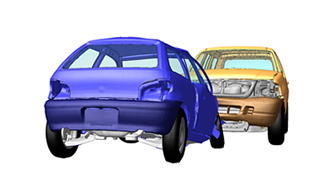
LS-DYNA opens the nonlinear world
The phenomena adopted for developing product designs are becoming increasingly complex: automotive crashes, metal forming, forging, large deformations of rubber materials, and failure of plastic parts. CAE simulation is now an essential tool for attaining a complex and high-quality design in various industries. LS-DYNA was originally introduced by Dr. John O. Hallquist at the Lawrence Livermore National Laboratory in the 1970s. In the late 1980s, Livermore Software Technology, LLC (LST, LLC) was founded to develop LS-DYNA as a commercial code. LST, LLC has been committed to developing LS-DYNA for solving nonlinear problems more precisely and stably. LS-DYNA is now known worldwide as one of the best nonlinear solvers and is used in both the academic and the industrial worlds.
"One model, one code" concept
Most of the functions in LS-DYNA are integrated into one code, instead of being divided into multiple modules. The software development period of LS-DYNA is shortened by sharing routines used by more than one function and by concentrating the development effort into one code. LS-DYNA users can perform simulation for a variety of industrial fields and can reduce the additional cost of introducing different software for each individual field.
Traditionally, engineers created mesh models suitable for use by the simulation method. They created more than one mesh model from one finite element (FE) model, either to adapt to the purpose of the simulation or to reduce the calculation time. In other words, one design required two or more simulation models. When the design had changed, engineers were required to reflect the change in all of these models. It is clear that engineers can dramatically reduce the time required to modify simulation models if they can reuse one simulation model. LS-DYNA’s “One model” concept and its functions allow users to apply one simulation model to many types of simulation, including structural, fluid, crash, and eigenvalue simulation.
Multi-Physics
Product development involves a variety of engineering difficulties: mechanical strength, countermeasures against heat, and others. As a result of limitations on resources, coupled simulation could be performed only for some special cases. On the other hand, the demand for introducing complex phenomena into product design is expanding. The development of LS-DYNA has continued to integrate a variety of engineering fields including structural, thermal, and fluid into one single program.
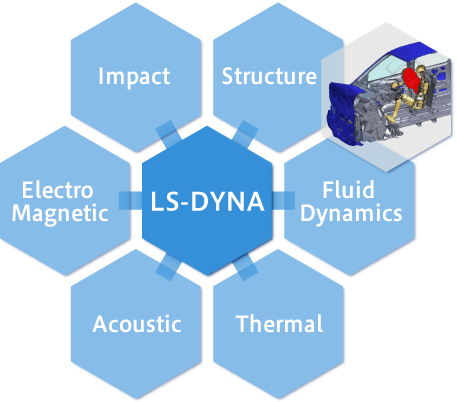 Multiple solvers: Capabilities and Solutions
Multiple solvers: Capabilities and Solutions
Multi-Stage
Multi-Stage simulations require realistic results. For example, a consecutive simulation chaining a series of process simulations by carrying forward the simulation result of the previous process to a later process, and a strength or crash simulation that contains work hardenings of metal or changes in thickness. LS-DYNA provides functions for considering the material's behavior during a multi-stage process: stress initialization and restart calculation which carries over the result obtained from the previous calculation. LST, LLC has conducted the development of these functions.
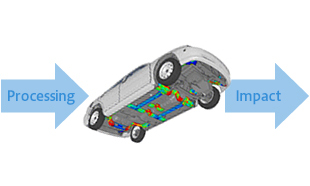 Crash simulation with work hardening
Crash simulation with work hardening
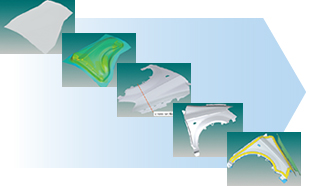 Multi-staged press forming simulation
Multi-staged press forming simulation
Multi-Process (Parallel computation)
To build an accurate model of actual phenomena and to obtain a precise simulation result, a large-scale simulation model is required. It is essential to use parallel computation to handle such a large-scale model and to complete the calculation within a reasonable calculation time. LS-DYNA can run a parallel computation regardless of the model size. For a relatively small computation, shared memory parallel (SMP) code is suitable. For a large computation, massively parallel processing (MPP) would be an option. Development efforts to achieve more scalable parallel computation are ongoing.
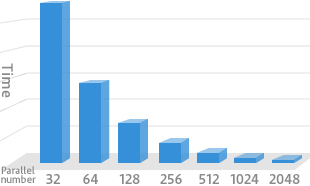 Fast computation with parallel computation
Fast computation with parallel computation
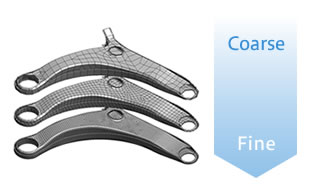 Precise model, Fast computation
Precise model, Fast computation
Range of applications
LS-DYNA can provide the actual behavior accurately along with its range of function. It covers a variety of industries and products from heavy industries' products, such as automobiles and aircraft, to precision parts for medical devices and precision instruments. Users can use LS-DYNA for most manufacturing processes, for example, from the product design including the study phase and framework to the detailed design, process design, and mold design. Furthermore, LS-DYNA can deal with a broad range of scales, from a macroscopic material's behavior to a large building structure's response. LS-DYNA can simulate various phenomena in the real world using a single solver.
Industries for application
The strengths of LS-DYNA are 1) a wide range of material models, including metal, rubber, plastic, and composite; 2) implicit and explicit time development schemes, implicit for robustness and explicit for reliability; 3) element types and hourglass control functions that accurately represent various deformation modes. These useful functions attract users from various industrial fields, primarily in the automobile, aircraft, construction, engineering, medical service, precision instruments, and energy fields.
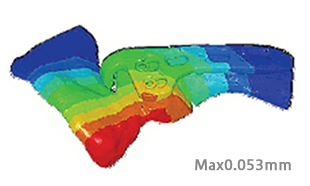 Medical field: Evaluation of the fixing plate for a clavicle fracture treatment
Medical field: Evaluation of the fixing plate for a clavicle fracture treatment
Data courtesy of R. Sakai, Ph.D., Kitazato University
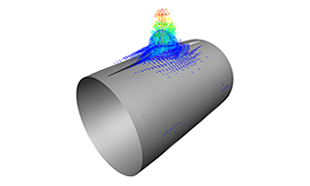 Energy field: Development of fractures through cracks on gas pipes
Energy field: Development of fractures through cracks on gas pipes
Support your manufacturing
Users in academic and industrial fields make use of LS-DYNA for research and manufacturing. LS-DYNA supports analyzing and revealing unknown phenomena to achieve an optimal manufacturing technique, in both research and actual manufacturing.
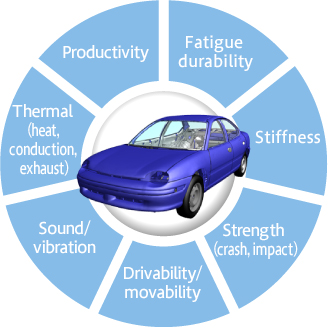 CAE capabilities
CAE capabilities
Broad physical scales
LS-DYNA applies the FE method to discrete structures resulting in no limitations on the time or physical scaling of an LS-DYNA simulation. In addition, various element types, material models, and implicit/explicit time developments allow users to simulate a wide range of physical scaling, from large structures to material structures.
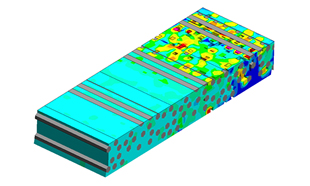 Internal structure simulation for UD composites
Internal structure simulation for UD composites
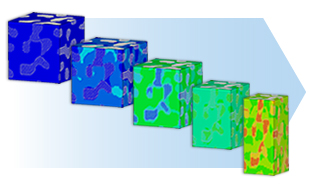 Mechanical properties of composite materials
Mechanical properties of composite materials
High compatibility with manufacturing technologies and process simulations
During the manufacturing process, including extrusion, bending, and stamping, engineers endeavor to manufacture products with minimal deviation from the design. Many phenomena observed at a manufacturing scene, especially large deformations, nonlinear properties of a material due to a large strain, and unintended contact with molds, are highly nonlinear and consequently difficult to solve using CAE. Experiences of JSOL and technologies of LS-DYNA offer the solution for such difficulties. JSOL has also developed software specialized in particular manufacturing simulations: JSTAMP, Jvision, and more.
Highly sophisticated solver LS-DYNA
LS-DYNA can resolve accurately many difficult phenomena seen during manufacturing. "Nonlinear" problems, including large deformations, nonlinear material (plastic, superelastic), and contact can be solved robustly, accurately, and quickly.
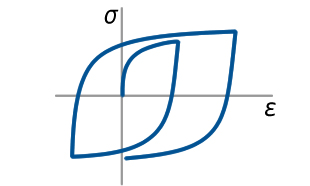 Kinematic hardening material model
Kinematic hardening material model
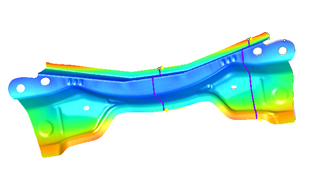 CAE for Manufacturing Engineering with high-performance solvers
CAE for Manufacturing Engineering with high-performance solvers
User-friendly simulation system full of professional know-how
JSOL provides simulation systems to assist your simulation with LS-DYNA specialized for particular manufacturing processes.
JSTAMP is an integrated forming simulation system that supports mold design and process planning for forming. Jvision is a pre/postprocessor with a customizable interface to handle the forming process the user is concerned with. With the help of Jvision, all users, from CAE beginners to experts, can make use of LS-DYNA easily.
Livermore Software Technology, LLC
The developer of LS-DYNA, Livermore Software Technology, LLC (LST, LLC), was founded in 1987 by Dr. John. O. Hallquist. The development of a public domain code called DYNA3D at Lawrence Livermore National Laboratory was continued at LST, LLC, which began delivering the software to the market as a commercial code called LS-DYNA. JSOL (former JAIS and JRI), which had performed porting and had provided the public domain code DYNA3D to users in its ow n terms began to distribute the commercial version, LS-DYNA. As one of the longtime partners of LST, LLC, JSOL has been involved in the development of some material models and now stations an engineer at LST, LLC to provide high-quality support service to users in Japan.
LST, LLC Web Site
- *Some models posted on this site are provided by NCAC/GWU.
- *Product names and service names are the trademarks or the registered trademarks of their proprietors.




